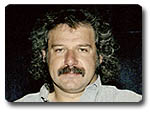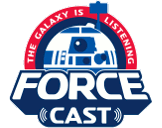

DVD VFX Supervisor - Pablo Helman
DVD Press Conference
September 7, 2001
JW - Jim Ward
VL - Van Ling
RM - Rick McCallum
PH - Pablo Helman
RD - Rick Dean
JS - Jon Shenk
JW: OK, next up is a gentleman named Pablo Helman who comes from Industrial
Light & Magic and Pablo was the Visual Effects Supervisor on all of the
newly created scenes that appear on the DVD. So Pablo, where are you?
There you are. I couldn't even see you before. OK, so this is the guy to talk
to about the process of putting together all
these new scenes. OK right here.
JW: How many people worked on the DVD and how long did the process take?
PH: I think we had a crew of about 100 people, actually over 100 people.
And it took between six and eight months.
JW: How did the process compare from doing a film versus the DVD to create
these scenes?
PH: Well the process was pretty much the same. At ILM we take pride in
every frame that we create, every pixel. So the process was basically the
same, taking a look at the old content we needed to put together into 300 or
so new shots. And taking a look at every one and all the history of Star
Wars and the Star Wars universe. And again, we had to create the scenes so
that they would cut right into the film if needed to. It was pretty hard
work but it paid off.
Q: Did you take it to film? Or just stayed on digital.
PH: No everything was delivered on film.
JW: In the world of Star Wars what is a quote/unquote deleted scene, and in
essence what did you have to do to actually create these scenes?
PH: Well all these scenes that you're going to see on the DVD were at some
point in part of the film. There were over 300 shots of scenes that were
not part of the movie. And there was all these descriptions, all these
different shots, and I basically sat down one night with a glass of wine and
took a look at the videotape and I think I told you the story before, as the
videotape kept going I was pouring more wine and more wine because the idea
of producing all these really quickly, you know six to eight months, it was
something that we had to think about. Again, you know when it comes to
content, everything that was in that videotape was at some point in the
movie. And it was deleted or not produced for a specific reason at the
time.
JW: Pablo, what state were those scenes in? They were basically blue
screen, right? So you had to go and.
PH: Yeah the majority of it was blue screen, and a lot of it was a lot of
sketchwork, you know artwork basically pencil drawings.
JW: So when you say it was in the film it literally was a placeholder in the film?
PH: Yeah. Well yeah but in terms of content it was at some point it was
part of the film, somebody, obviously George had thought this is what I want
in my film. In terms of how we went about filming all that blue screen and
all those blanks, we had a huge library of elements and things handy shot
(?) that was again there was a history of Star Wars so there was really very
little leeway to go wrong. And some things we shot, elements we shot. A
lot of it was CG. And some things that we couldn't do before for different
reasons. For instance the waterfall scene, at the time they were doing
Episode I, it was very costly to do. There was a lot of R&D in that. And
by the time that they were working the DVD basically the whole facility was
working on water because there were a lot of water projects. So waterfalls
were a perfect way for us to develop that technology and put it to use.
JW: Did you do any other work beyond the deleted scenes?
PH: Yeah we did the outtakes too. Those were a lot of fun too.
JW: What is the previsualization process like and what happens?
PH: Well, at some point George has an idea and he communicates that idea to
somebody. And then that person puts together, it's basically a dialogue
between the Art Department and the Director, in which the Director says
something and the Art Department says here, this is what you want. And then
the Director says well yes/no. When you're doing animatics you're not
thinking about how you're actually going to finish a shot. You're just
basically brainstorming up with your own idea on paper or videotape or CD or
whatever your medium will be. After that, from a visual effects point of
view when I see animatics all the time when we're working it's a great tool
because it's a lot easier for, especially for artists who are very
subjective minded, I mean everything is very, very subjective. It's a lot
easier to say here do this, match this than to say I have this idea this is
a waterfall right here that I want it to go down. So from that sense it was
great. I do have to say that George gave us a lot of freedom, from those
animatics that were very ambitious and varied, but very, very open. We had
the leeway to solve the problems in terms of content. For instance in the
pod race, when I remember looking at the animatic and there was something in
the pod race in that extra lap that we did in which Anakin loses the cable,
and I mean it took me about three or four viewings to realize what that was.
You know it's like, there's something there, what do you think? Well I
think it's a cable. Well where does that come from? Well we actually didn'
t ask George those questions, because you don't sit down with George to
ask -- what did you mean, is that a cable there? So we had to basically
solve all those problems. So animatics are very crude and it's a very open
way to present a visual effects problem.
JW: And just so you understand the process at Lucasfilm is that there is a
previsualization team that's separate from Industrial Light & Magic led by a
guy named David Dozoretz. And basically George works with him to develop
the animatics, previsualization of the film and then that's what ILM tee's
off of in terms of understanding what the action sequence is going to be.
Q: How were the deleted scenes selected in the reintroduction?
JW: Why don't I
take that. Deleted scenes were selected by George, basically, to answer
that question. And in terms of the reintroduction you saw the taxi sequence
scene that makes sense to him after seeing it completed and he
reincorporated that into the film.
Q: In the deleted scenes that you did is there anything that's special or a
small bit that you're most proud of?
PH: The waterfall sequence is great. The pod race sequence is great when
you think about the technical hurdles that we had to go through. The taxi
sequence was great because it allowed us to take a tour of Coruscant in a
way that we hadn't seen before, and prepared us for future stories about the
city.
JW: Why don't you tell them the story you told me about the computer?
PH: Well there is a scene before the pod race where we introduced all these
different pod racers that we didn't have a chance to see in Episode I. When
we took a look at the animatic there was basically a still of Ben Quadinaros
who is a character that never completes the pod race in the actual film
because his engine explodes. So taking a look at the animatic and trying to
figure out (just like with the cable), what that shot was going to look
like, we though well we can put Ben Quadinaros we have a CG character which
is zooming to him and that'll be it. And then some of us thought well wait
a minute, he never finishes the race, because his engine explodes. Why don'
t we have him over there reading the manual? Right before the race? He's
reading a manual and you know he just stops and just throws the manual away.
And so we made that and we completed the shot and then here we go six months
later we were talking to George throughout all these meetings but we never
told him exactly the content of this establishing shot. So here we go, I'm
meeting with George, playing the tape and showing him these short cuts, and
he sees the manual and then he stops the tape and says, "You know, you did
something wrong here." And I said, "What did we do?" He said, "In the Star
Wars universe there are no books. So, go ahead and put a laptop in." So
that kind of exchange with George in terms of what the Star Wars universe is
and what kind of backstories there are in Star Wars is a great opportunity
that not many people have a chance to benefit from.
JW: OK, that's great, thanks a lot, appreciate it.

